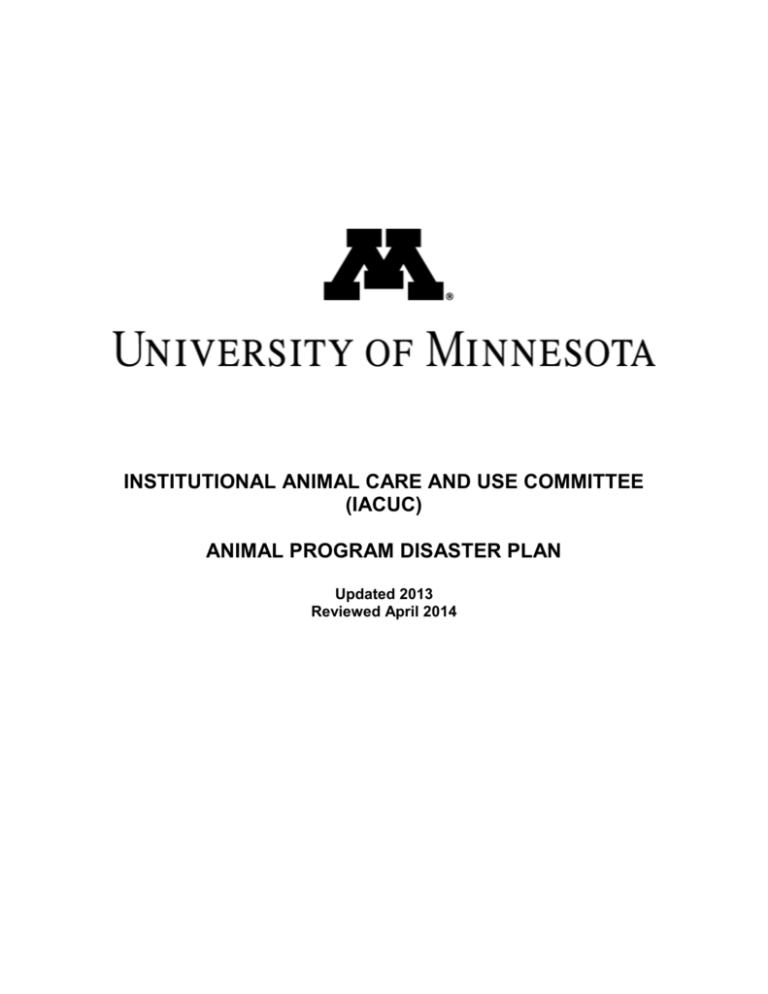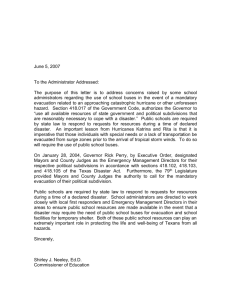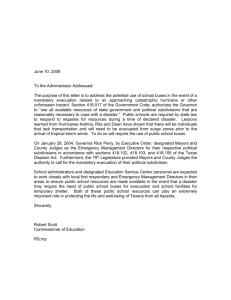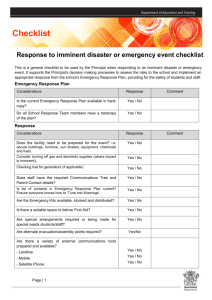Disaster/Emergency Planning - Office of the Vice President for
advertisement

INSTITUTIONAL ANIMAL CARE AND USE COMMITTEE (IACUC) ANIMAL PROGRAM DISASTER PLAN Updated 2013 Reviewed April 2014 TABLE OF CONTENTS I. PURPOSE, SCOPE, GOALS II. BACKGROUND III. CHAIN OF COMMAND IV. EMERGENCY PLAN ACTIVATION CRITERIA V. ACTION PLANS VI. MATERIALS and RESOURCES VII. TRAINING VIII. EXTERNAL COORDINATION IX. RESPONSE and RECOVERY X. ADDITIONAL INFORMATION a. Preservation of critical/irreplaceable animals b. Plans for procedural locations c. Site Specific Plan Templates I. PURPOSE, GOALS, SCOPE PURPOSE: The purpose of this document is to provide an overall plan of action for responding to emergencies that may impact the research and teaching animals housed at the University of Minnesota. The maintenance of animal health and welfare is a critical research service at risk from the anticipated consequences of a disaster. GOAL: Provide a plan for humane handling, treatment, transportation, housing and care of the animals during a disaster which ensures: – – – employee safety, health and welfare animal safety, health and welfare continuity of care SCOPE: This plan covers all animals housed under the auspices of the University of Minnesota with oversight from the Institutional Animal Care and Use Committee. Each housing or animal use site is responsible for developing and implementing a plan which ensures appropriate training for actions necessary to protect animal and employee safety during an emergency event. II. BACKGROUND Emergency response and recovery plans are required by the PHS Policy on Humane Care and Use of Laboratory Animals, the Guide for the Care and Use of Laboratory Animals (Guide), the Guide for the Care and Use of Agricultural Animals in Agricultural Research and Teaching (Ag Guide), and the USDA Animal Welfare Act Regulations. III. CHAIN OF COMMAND This plan is coordinated by the University of Minnesota Institutional Official (IO) for the Animal Care and Use Program, who is also the Vice President for Research. The IO has responsibility for determining and communicating to the University community all research-related response actions during a disaster. This plan is included in the overall institutional emergency plan. The Attending Veterinarian, who is also the Director of Research Animal Resources (RAR), will be responsible for oversight and review of this plan and for notifying the IACUC and relevant regulatory agencies in the event an emergency occurs. Upon notification by the IO, study directors, principal investigators, course instructors, and farm and facility managers will be responsible for activating the applicable site specific plan with regard to the animals under their care. This plan has been approved by the Institutional Animal Care and Use Committee. The Department of Emergency Medicine, law enforcement, security and emergency personnel have been consulted and have access to this plan. IV. EMERGENCY PLAN ACTIVATION CRITERIA Most Likely Emergencies: sustained power outage or loss of water supply, sustained ventilation failure, fires, flooding from plumbing system, blizzard/tornado causing damage to structures or preventing staff from reporting to work, animal rights incursion/civil disturbance The disaster plan will be activated by the Institutional Official, who is also the Vice President for Research (VPR), and/or the Office of the Vice President for Research. The activation of the plan will be communicated via email and/or U-text messaging from the OVPR to the appropriate responsible personnel. V. ACTION PLANS 1. Communication/contact methods and plans to activate a. Each Animal Housing Facility must have a prominent sign labeled with appropriate contact personnel (Principal Investigator; Primary Laboratory Contact; Attending Veterinarian, Facility Supervisor/Manager, etc.) and associated emergency phone numbers and emails. b. The University of Minnesota’s Department of Emergency Management has promulgated a system of requiring a Building Emergency Plan (BEP) for each building on campus which includes site specific information on evacuation plans, the location of emergency equipment, and addresses to communicate to emergency personnel. RAR maintains a BEP portfolio for the buildings which contain animal facilities. 2. Triage a. NEVER ENDANGER YOUR PERSONAL SAFETY b. Evaluate overall situation (see flowchart at end) c. If advance notice of impending emergency (e.g.. weather) has been given, initiate assessment of supply storage needs d. Assess structures (is it safe to enter?), defer to Incident Commander if present e. If the disaster results in down-time that is less than 24 hours, on-site care (aka shelter-in-place) of the animals will be the standard approach. f. If the disaster, and/or resulting down-time, is such that the ability to provide onsite care is significantly impaired, animals should be evacuated and/or euthanized depending on assessment of the situation and the probable timing of return to normal. 3. General provisions for care and maintenance of the animals - either prior to personnel evacuation, if advance notice of emergency is given (e.g. blizzard, pandemic flu), or after Incident Commander allows building entry. a. Fill all food containers in animal rooms with food. b. Fill all receptacles with water (plastic lined garbage cans, carboys, etc.). c. For animals on automatic water (rodents in IVC racks, some NHPs, etc.) place extra water bottle on cage. d. Aquatics i. Fill extra tanks with de-chlorinated water. ii. Feed per SOP iii. Ensure water levels in aquatic tanks are adequate e. In the event of power failure i. If applicable, verify that all ventilated cage racks are plugged into emergency power outlets and are operational. If units are not operational, open doors to animal rooms to aid in ventilation. ii. Open all animal room doors to interior hallway. 4. Animal Evacuation Plans: a. Small-scale incident (e.g., those involving 1 - 4 animal housing rooms) Animals should be relocated to nearby rooms or facilities with the goal of continuing routine animal care procedures. Available space should be evaluated in terms of strengths and weaknesses in accommodating the species to be moved, equipment needed, and staff to reassign as needed. b. Medium-scale incident (e.g. large segments of a facility or building, including animal treatment rooms): Animals may be relocated (in cages plus cage racks, transport cages, etc.) to essentially open available space (corridors, tunnels, receiving dock). These spaces are not designed to house animals and would be a temporary stop-gap as animal care would be severely constrained by the lack of environmental control, lack of design features such as HVAC, plumbing, etc. The goal of this evacuation would be to save animal lives when no alternative is available or as a temporary solution prior to primary relocation. c. Large-scale incident (e.g. whole buildings, animal facilities, campus are impacted) Relocation of animals to a different building or campus, as transportation is available. The goal of this approach is to get the animals to a new location in which basic animal care procedures can be performed. 5. Animal Euthanasia: In the event that all other options have been exhausted, the Institutional Veterinarian can give the order that animals should be humanely euthanized. Any responsible veterinarian can make a euthanasia determination at any point in time about specific animals based on their health and welfare, but only the Institutional Veterinarian can make the determination that all animals will be euthanized. VI. MATERIALS and RESOURCES a. Store a supply of food, bedding, water (or water substitute like hydrogels) and PPE (personal protective equipment) at all times. b. Ensure adequate euthanasia and basic medical supplies for all animals on census c. Obtain and store the following supplies: flashlights/head lamps, batteries, first-aid kit d. For locations that may require animal care staff to remain on site overnight, obtain and store air mattress/cots, food rations for personnel, head lamps, drinking water. e. Ensure essential personnel have necessary access, keys to supply storage, etc. f. Create/maintain census information of animals, rooms/pens, investigator contacts, and protocol numbers. VII. TRAINING a. Provide and maintain documentation of participation in, and completion of, training of all current staff, all new staff within 30 days of hire, all staff on changes within 30 days of revision b. Animal care and veterinary staff must be instructed that responding to emergencies is a condition of employment and that they will be held accountable should they fail to care properly for the animals. c. Read, learn and know the plan d. Review contact information for emergency responders and practice same e. Develop back-up methods for contacting emergency responders f. Know response equipment materials location and use g. The plan must be updated and exercised by conducting evacuation drills at least annually. VIII. EXTERNAL COORDINATION The Department of Emergency Management (DEM) will maintain regular communications with the State Department of Public Safety, Homeland Security and Emergency Management Division, as well as other city and county emergency managers, throughout the duration of a disaster. For emergencies affecting staff and patients, the Academic Health Center Office of Emergency Response (AHC-OER) will maintain communications with the Minnesota Department of Health and local public health departments, through 24/7 monitoring of the Health Alert Network, MNTrac (Minnesota system for Tracking Resources, Alerts, and Communications), and through direct communications. AHC-OER will also receive all requests for health response assistance from state and local partners, such as requests for assistance from the U of M Medical Reserve Corps. Those requests will be reviewed by the Health Emergency Response Team per existing standard operating procedures. All other requests for mutual aid will be managed by DEM. IX. RESPONSE and RECOVERY a. Once access is granted back in to the facility, the environmental conditions must be assessed and recommendations communicated if conditions need to be improved. b. Locate areas of known hazards (or animals injected with hazards); stabilize these animals and environments first. c. Animal health assessments should be completed in order to provide critical care and maintain biosecurity. Triage all animal survivors and classify them into categories of health and exposure to environmental conditions outside of the cage. Remove animal carcasses and store for disposal. d. Conduct brief animal inventory to assess potential for escapes or animals unaccounted for. e. Provide animal enclosure cleaning as necessary to minimize animals being in wet or dirty cages. If equipment or power failure still exists, hand sanitization of caging or other equipment with a diluted bleach solution and rinse may be necessary f. Euthanasia determining factors: – Pain/distress, beyond rescue – Availability of feed, caging, rooms, environment, species requirements – Investigator input, unless suffering as determined by veterinarian – Loose, unidentified animals – Euthanasia should only be completed by a trained individual X. ADDITIONAL INFORMATION a. Preservation of critical/irreplaceable animals: Laboratory specific emergency and hibernation plans are expected to address consideration of cryopreservation or other means of preserving irreplaceable animals. b. Procedural locations: Surgery, Behavioral Testing, etc. also need animal specific emergency response plans. The IACUC may request to see that information as part of protocol review or semiannual inspection. c. Site Specific Plan Templates, required for Investigator Managed Housing Areas in continuous use, Agricultural Units, non-Twin Cities campuses, and other locations housing University owned animals, are available from the IACUC and the Department of Emergency Management. d. For questions and assistance with the Animal Program Disaster Plan, contact the IACUC at 612-626-2126. References USDA Animal Welfare Act disaster contingency planning - http://www.nal.usda.gov/awic/pubs/IACUC/dis.htm - http://awic.nal.usda.gov/research-animals/disaster-planning NIH Office of Laboratory Animal Welfare disaster planning - http://grants.nih.gov/grants/olaw/disaster_planning.htm Guide for the Care and Use of Laboratory Animals - http://grants.nih.gov/grants/olaw/Guide-for-the-Care-and-Use-of-LaboratoryAnimals.pdf - pg 35 Guide for the Care and Use of Agricultural Animals - http://www.fass.org/docs/agguide3rd/Ag_Guide_3rd_ed.pdf - pg 22 Institute for Laboratory Animal Resources - http://dels-old.nas.edu/ilar_n/ilarjournal/51_2/html/pdfs/v5102Wingfield.pdf Safety at the University list of resources - http://www1.umn.edu/prepared/plans_who.html DEHS Laboratory Hibernation Plan checklist - http://www.dehs.umn.edu/Docs/AppQ%20Hibernation%20Plan.doc Department of Emergency Management - http://www.dem.umn.edu/ ANIMAL PROGRAM EMERGENCY ACTION PLAN TRIAGE EMERGENCY NOTIFICATION RECEIVED CAN YOU CONDUCT OPERATIONS FROM CURRENT LOCATION? YES NO ENSURE PERSONNEL SAFETY MOVE ANIMALS TO ALTERNATE LOCATION ADDITIONAL RESOURCES / HELP NEEDED? INITIATE CALLING TREE CALL 911 as needed for NEW ISSUES EVALUATE SITUATION YES DURATION LIKELY TO BE GREATER THAN 72 HOURS? NO NOTIFY RESPONSIBLE PERSONNEL AND INVESTIGATORS CONTINUOUSLY RE-EVALUATE SITUATION UNTIL RESOLVED








